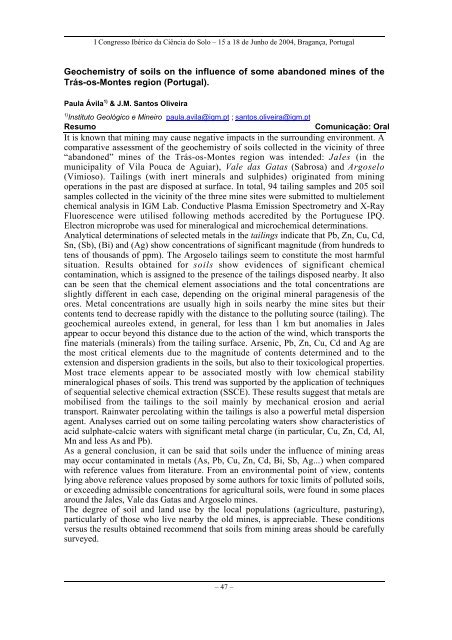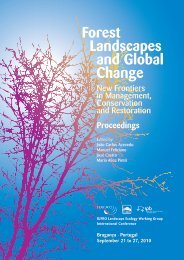Programa e Resumos - I Congresso Ibérico de Ciência do Solo 2004
Programa e Resumos - I Congresso Ibérico de Ciência do Solo 2004
Programa e Resumos - I Congresso Ibérico de Ciência do Solo 2004
Create successful ePaper yourself
Turn your PDF publications into a flip-book with our unique Google optimized e-Paper software.
I <strong>Congresso</strong> Ibérico da Ciência <strong>do</strong> <strong>Solo</strong> – 15 a 18 <strong>de</strong> Junho <strong>de</strong> <strong>2004</strong>, Bragança, Portugal<br />
Geochemistry of soils on the influence of some aban<strong>do</strong>ned mines of the<br />
Trás-os-Montes region (Portugal).<br />
Paula Ávila 1) & J.M. Santos Oliveira<br />
1) Instituto Geológico e Mineiro paula.avila@igm.pt ; santos.oliveira@igm.pt<br />
Resumo<br />
Comunicação: Oral<br />
It is known that mining may cause negative impacts in the surrounding environment. A<br />
comparative assessment of the geochemistry of soils collected in the vicinity of three<br />
“aban<strong>do</strong>ned” mines of the Trás-os-Montes region was inten<strong>de</strong>d: Jales (in the<br />
municipality of Vila Pouca <strong>de</strong> Aguiar), Vale das Gatas (Sabrosa) and Argoselo<br />
(Vimioso). Tailings (with inert minerals and sulphi<strong>de</strong>s) originated from mining<br />
operations in the past are disposed at surface. In total, 94 tailing samples and 205 soil<br />
samples collected in the vicinity of the three mine sites were submitted to multielement<br />
chemical analysis in IGM Lab. Conductive Plasma Emission Spectrometry and X-Ray<br />
Fluorescence were utilised following methods accredited by the Portuguese IPQ.<br />
Electron microprobe was used for mineralogical and microchemical <strong>de</strong>terminations.<br />
Analytical <strong>de</strong>terminations of selected metals in the tailings indicate that Pb, Zn, Cu, Cd,<br />
Sn, (Sb), (Bi) and (Ag) show concentrations of significant magnitu<strong>de</strong> (from hundreds to<br />
tens of thousands of ppm). The Argoselo tailings seem to constitute the most harmful<br />
situation. Results obtained for soils show evi<strong>de</strong>nces of significant chemical<br />
contamination, which is assigned to the presence of the tailings disposed nearby. It also<br />
can be seen that the chemical element associations and the total concentrations are<br />
slightly different in each case, <strong>de</strong>pending on the original mineral paragenesis of the<br />
ores. Metal concentrations are usually high in soils nearby the mine sites but their<br />
contents tend to <strong>de</strong>crease rapidly with the distance to the polluting source (tailing). The<br />
geochemical aureoles extend, in general, for less than 1 km but anomalies in Jales<br />
appear to occur beyond this distance due to the action of the wind, which transports the<br />
fine materials (minerals) from the tailing surface. Arsenic, Pb, Zn, Cu, Cd and Ag are<br />
the most critical elements due to the magnitu<strong>de</strong> of contents <strong>de</strong>termined and to the<br />
extension and dispersion gradients in the soils, but also to their toxicological properties.<br />
Most trace elements appear to be associated mostly with low chemical stability<br />
mineralogical phases of soils. This trend was supported by the application of techniques<br />
of sequential selective chemical extraction (SSCE). These results suggest that metals are<br />
mobilised from the tailings to the soil mainly by mechanical erosion and aerial<br />
transport. Rainwater percolating within the tailings is also a powerful metal dispersion<br />
agent. Analyses carried out on some tailing percolating waters show characteristics of<br />
acid sulphate-calcic waters with significant metal charge (in particular, Cu, Zn, Cd, Al,<br />
Mn and less As and Pb).<br />
As a general conclusion, it can be said that soils un<strong>de</strong>r the influence of mining areas<br />
may occur contaminated in metals (As, Pb, Cu, Zn, Cd, Bi, Sb, Ag...) when compared<br />
with reference values from literature. From an environmental point of view, contents<br />
lying above reference values proposed by some authors for toxic limits of polluted soils,<br />
or exceeding admissible concentrations for agricultural soils, were found in some places<br />
around the Jales, Vale das Gatas and Argoselo mines.<br />
The <strong>de</strong>gree of soil and land use by the local populations (agriculture, pasturing),<br />
particularly of those who live nearby the old mines, is appreciable. These conditions<br />
versus the results obtained recommend that soils from mining areas should be carefully<br />
surveyed.<br />
– 47 –
















